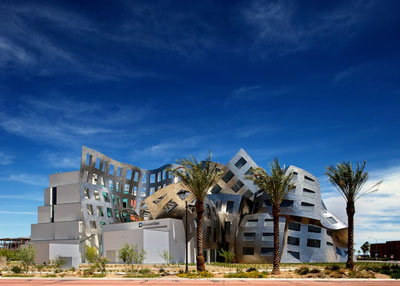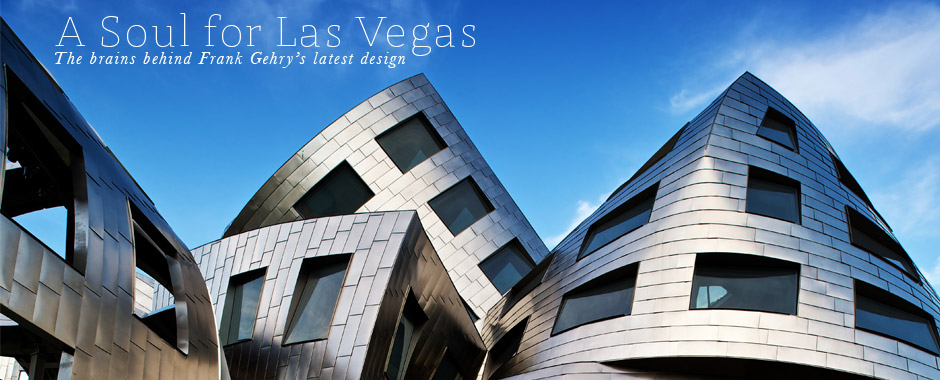 by G. James Daichendt | photos by Matt Carbone
by G. James Daichendt | photos by Matt Carbone
 Architecture is perhaps the greatest and most important art ever created. Frank Lloyd Wright referred to it as the mother art, without which we would have no soul for civilization. At its best, architecture is pragmatic and creative, a place where one’s dreams can be realized.
Architecture is perhaps the greatest and most important art ever created. Frank Lloyd Wright referred to it as the mother art, without which we would have no soul for civilization. At its best, architecture is pragmatic and creative, a place where one’s dreams can be realized.
Frank Gehry’s latest architectural endeavor is no different. In fact, the Cleveland Clinic Lou Ruvo Center for Brain Health in Las Vegas represents the hope for a better future in physical form. It’s the story of an architect that created a place where science and care can blossom.

Las Vegas is a city of spectacle. New construction is constantly
reaching for new heights. Hotels display wild and bizarre themes that combine to create a clumsy mishmash of buildings during the day and a heavenly array of lights by night. Las Vegas seems like an
ideal location for a Frank Gehry designed building with many cultural institutions attempting to place a stake in Sin City, but perhaps this is why he has resisted past invitations.
Instead it was for very personal reasons that Gehry brought his iconic twists and turns to the city. Larry Ruvo, a spirit and wine distributor, initiated the dream for establishing a neurological research facility after watching his father suffer through Alzheimer’s. In addition, Gehry experienced similar struggles with close friends that suffered from Huntington’s disease, a devastating neurological affliction that is now supported by Keep Memory Alive.
The architect also served on the board of Wexler’s Hereditary Disease Foundation for nearly 35 years. This foundation was established to study Huntington’s disease. These emotional histories are perhaps why the building itself is a welcome place to visit and does not hold the cold features that so many scientific and medical institutions display. Even detractors of Gehry’s aesthetic are surprisingly affected by the story and philosophy behind the building. Gehry explains, “The mantra is Keep Memory Alive. I’m trying to make a building that people will want to visit, remember, talk about, enjoy, and ultimately will want to partner with us at the Center to help cure some of the neurodegenerative diseases.”
But how does one compete with the spectacle that is Las Vegas? Chaotic and impractical upon first glance, the imaginative scaffolding has a surprising meaning and function. A combination of creativity and pragmatism, it represents the dual nature of the facility and of Gehry’s artistic process as well.
A symbolic exploration, the structure of the building itself is an allusion to the two hemispheres that make up the brain. The north side of the building represents the more rational left hemisphere. These spaces are dedicated towards research, and the structured and geometric aesthetic references the organization that the medical profession requires.
In contrast, the south side of the building is indicative of the creative, right hemisphere of the brain. The sweeping lines of the stainless steel exterior twist and turn as though a giant sculpted it. Windows face upward and turn away from any traditional notion of what a building should look like. The tenets of architecture are deconstructed and reimagined, a paradigm shifting aesthetic that we now associate with the architect.
The two sides combine to create The Cleveland Clinic Lou Ruvo Center for Brain Health, an exciting new addition whose mission provides a new soul for Las Vegas.

 by G. James Daichendt | photos by Matt Carbone
by G. James Daichendt | photos by Matt Carbone